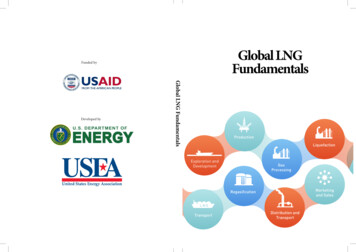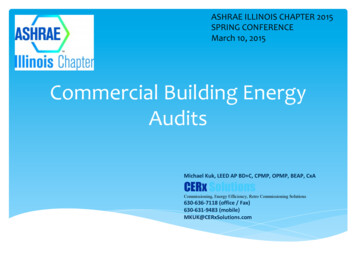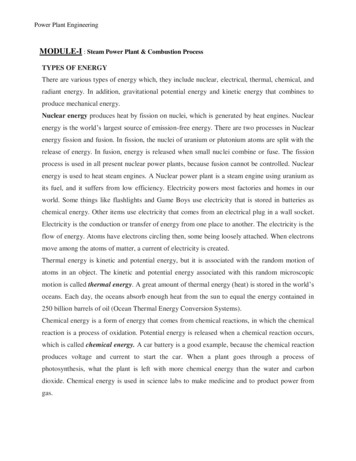
Transcription
Funded byGlobal LNGFundamentalsFundedFunded bybyFunded byGlobal LNG ed bybyContributing PartnersContributingContributing PartnersPartnersLiquefactionExploration andDevelopmentLiquefactionGhana Ministry ofPetroleumProductionExploration gGasProcessingLiquefactionMarketingand SalesLNGTransportRegasificationDistribution andTransportLNGTransportDistribution andTransportMarketingand Sales
Acknowledgment: This material is based upon work supported by theDepartment of Energy under Award Number DE-FE0024160.Disclaimer: This version of the LNG handbook was based on a book that wasprepared as an account of work sponsored by an agency of the United StatesGovernment. Neither the United States Government nor any agency thereof, nor anyof their employees, makes any warranty, express or implied, or assumes any legalliability or responsibility for the accuracy, completeness, or usefulness of anyinformation, apparatus, product, or process disclosed, or represents that its usewould not infringe privately owned rights. Reference herein to any specificcommercial product, process, or service by trade name, trademark, manufacturer, orotherwise does not necessarily constitute or imply its endorsement,recommendation, or favoring by the United States Government or any agencythereof. The views and opinions of authors expressed herein do not necessarily stateor reflect those of the United States Government or any agency thereof.This version of the handbook has been edited to make it more universal and lessfocused on Africa. This version has been updated by the Office of InternationalAffairs at the U.S. Department of Energy and any changes were made only by theDepartment of Energy and not the original authors. This edition is current as ofOctober 2017The original book and other supplemental information can be found at the below natural-gas-and-lng-optionsThe original book and the broader Global LNG Handbook can also be found using thebelow velopment-natural-gas-markets-andlng-optionsThe original handbook was produced using the "Book Sprint" (http://www.booksprints.net) collaborative writing method.
Foreword2IntroductionGlobal Gas MarketIntroductionSupply and Demand Balance GlobalShipping Considerations691215LNG and Domestic Gas Value ChainsIntroduction17LNG Value Chain18Domestic Gas Value Chain22Domestic MarketIntroduction25Domestic Use of Gas26Natural Gas Power Generation29Market Structure3538Elements of a Gas Master Plan
Structuring an LNG ProjectIntroduction44Choosing a Project Structure46Driving Factors on Choice of Structure51Import Project Structures54Government RoleIntroduction56Gas Policy and Regulatory Framework57Legislation and Fiscal Regime62Institutional Framework67Stakeholder Participation68Government Participation69Roles of Regulator71Capacity BuildingIntroduction73Training74Transparency and Openness75Technology Transfer76LNG DevelopmentIntroduction79Resource Reserve Estimate80LNG Project Development Phases81FEED84EPC Contractor Bidding and Selection85Final Investment Decision (FID)88
EPC Stage89LNG Technology Schedule92Estimate94Key Success Factors96Environment, Social Impact and SafetyIntroduction98Environmental Impacts of LNG Facilities100Safety105Social and Economic Impact109Social and Economic Development Plan - "Social License to Operate"111PricingIntroduction114LNG Reference Market Price115Price Indexation118Oil Indexed Price Formula120Spot and Short-Term Markets122Netback Pricing124Price Review or Price Re-openers126Recent Pricing Issues129LNG and Gas ContractsIntroduction132PSC v. Licenses133Preliminary Agreements134Domestic Gas Sales Agreement135
LNG Sale and Purchase Agreement137Miscellaneous Agreements142Financing an LNG Export ProjectIntroduction146Project Finance Structure148The Financing Process152Available Funding Sources156Impact of Market Shifts on Project Finance162Risk ManagementIntroduction165Risk Management and LNG Business166Types of Risk in LNG168Local ContentIntroduction172Definition of Local Content173Developing an Effective Local Content Policy175Implementation of Local Content Policy177Stakeholder Engagement181Ancillary Infrastructure Development183Managing Expectations184Comparing Local Content Policies185LNG Import ProjectsIntroduction187Project Development188
Import Commercial Structuring191Commercial Agreements200Financing Import Terminals and FSRUs203New and Emerging LNG/CNG MarketsIntroduction208LNG by Truck/LNG by Rail209Small-Scale LNG210Emerging LNG Marine Transportation Options211Peaking and Storage212Mid-Scale Virtual Pipeline Projects213Conversion Tables, Acronyms and DefinitionsNatural Gas Conversion216LNG Units Conversion217Acronyms and Definitions218
Foreword
FOREWORDThis handbook is the result of an effort by a diverse group of globalexperts who created this handbook in the hope that it can facilitate ashared understanding between government officials and companiesabout the technical, commercial, and economic factors that will spurinvestment gas and power. This handbook is intended to informdecision-making on options to develop natural gas. It does not promoteany specific business model, but rather promotes better understandingof the stakeholders' shared aims in developing natural gas and LiquefiedNatural Gas (LNG) projects and opening markets for LNG trade.Whether a country is a potential exporter or importer of natural gas, thishandbook will provide a framework to evaluate natural gas and LNG projectscritical to monetizing many of the large natural gas fields recentlydiscovered while matching resources with demand from regional and globalmarkets.The original version of this book is the third volume of Power Africa's“Understanding” series of handbooks that illustrate best practices fordeveloping energy projects in sub-Saharan Africa.The authors of the original Africa focused handbook, all of whomcontributed their time on a pro-bono basis, included experts fromgovernments, a multilateral development bank, international industry,financial institutions, consultancies, academia, and law firms. The outcomeis a product that reflects collective teamwork rather than the personalviews of individual authors or the institutions they represent. This versionincludes U.S. Department of Energy updates current as of October 2017We hope this handbook, and any following dialogues that it engenders, willimprove information flow and build human capacity that accelerates naturalgas development, cleaner power generation, energy security, economicgrowth, and environmental stewardship.Special thanks to Power Africa and USAID for funding the Africa version ofthis book.2
FOREWORDThe original handbook contributing authors:Ezekiel AdesinaBen AsanteNatalia CambaSenior Business & Strategy AnalystNigeria LNG limitedNigeriaGas AdvisorMinistry of Petroleum GhanaHead of Supervision & SafetyNational Institute of PetroleumMozambiqueFisoye DelanoRichard DonohoeNicholas J. FulfordSenior Vice President (Gas & Power)CAMAC International LtdUnited StatesAdjunct Professor, University ofIbadan, Centre for Petroleum,Energy Economics and Law (CPEEL)NigeriaManaging DirectorBerkeley Research GroupUnited StatesGlobal Head of Gas & LNGGaffney, Cline & AssociatesUnited StatesPaulino GregorioJames JewellU.H. Paul JonesAdvisor to the BoardEmpresa Nacional DeHidrocarbonetosMozambiqueInternational Energy AnalystOffice of International AffairsMiddle East and AfricaU.S. Department of EnergyUnited StatesFormer ExxonMobil LNG ExecutiveUnited StatesEng. Joyce KisamoSally KornfeldNorman LeeTechnical AdvisorPresident's OfficeTanzaniaDivision DirectorInternational Oil and Natural GasEngagementU.S. Department of EnergyUnited StatesCommercial ManagerMobil Producing NigeriaNigeriaMelanie LovattJohn MauelSusan SakmarFinance Advisor, BusinessIntelligencePoten & PartnersLondonHead of Energy TransactionsNorton Rose FulbrightUnited StatesVisiting Law ProfessorUniversity of Houston Law CenterUnited StatesHarry SullivanThomas ViotAssistant General Counsel, KosmosEnergy LimitedAdjunct Professor, Texas A&MUniversity School of LawAdjunct Professor, SMU, DedmanSchool of LawUnited StatesPrincipal Domestic Linkages OfficerAfrican Natural Resources CenterAfrican Development BankIvory Coast3
Introduction
INTRODUCTIONLNG trade is poised to be an important catalyst for economic growth inmany countries. Natural gas and LNG development can enable economicdevelopment and stimulate further investment in national infrastructure.Large natural gas discoveries have focused the attention of theinternational oil and gas industry on LNG export projects that are essentialto monetize these resources. Large gas resources are expensive to developand projects may not be able to clear investment hurdles if dedicated solelyto the domestic gas market in many developing countries. Developing anLNG export project and reserving a portion of the gas production for thedomestic market - with the full support of the host government - can makenatural gas available for local use in addition to earning revenue throughexport. This can enable the development of a diverse market for gasincluding power generation, local and regional industrial and commercialenterprises, transport, feedstock for petrochemical manufacturing, andother domestic uses of gas for the local population. LNG imports couldalso enable the development of domestic gas markets. Floating Storageand Regasification Units (FSRU’s) are increasingly being used to provide aflexible, effective way to receive and process shipments of LNG to meetgas demand in onshore markets or as a temporary solution until domesticgas is developed or onshore facilities are built.This handbook attempts to cover a broad spectrum of topics involved withdeveloping and financing an LNG project, covering in depth theconsiderations for an LNG export project and development of a diversedomestic market. The book also addresses LNG import projects for localLNG sales as an alternative to country-to-country pipelines. We discuss thedecisions that need to be made and the lenses through which to view thefactors leading to these decisions. Each country will need to make its owndecisions based on its specific national priorities, trade agreements, GDPgoals, and assessments of changing political and market dynamics.In the following chapters, the reader will find overviews of the global gasmarket, LNG and domestic gas value chains, and domestic andinterconnected regional markets for LNG and natural gas. We discuss projectstructure, government roles, capacity building, LNG export projectdevelopment, environment, social impact, and safety. We also review pricing,contracts, financing, risk management, local content, LNG import projects,and new and emerging markets and technologies for natural gas and LNG touching on successes from more mature markets such as the EU, Asiaand the U.S. that might inform future natural gas and policy decisions.6
INTRODUCTIONThis reference is not intended to be comprehensive. Governments wouldneed to employ the services of experienced advisors in legal, contractual,financial, technical and strategic areas. This advice should be directed atrapidly promoting the training of governmental staff, using all meansavailable, including well-established academic institutions that focus onthe oil and gas or LNG sectors.7
Global GasMarketIntroductionSupply and Demand BalanceGlobal ShippingConsiderations
GLOBAL GAS MARKETIntroductionGlobal gas demand has increased over the past decade and is expected togrow rapidly into the future with increased interest by governments inclean energy to fuel economic growth. Historically, most natural gas hasbeen sold locally or by gas pipeline to adjacent markets. Liquefaction ofnatural gas into LNG allows the gas to be transported fromproducing regions to distant countries. There are vast known globalnatural gas resources that are considered 'stranded' becausecompanies are not able to economically produce and deliver resourcesto markets.LNG HistoryThe U.S. has been a leader in the LNG industry since its inception. In 1959,the world's first LNG carrier, the Methane Pioneer, set sail from LakeCharles, Louisiana with a cargo of LNG destined for Canvey Island, UK. Thisfirst ever U.S.-UK shipment of LNG demonstrated that large quantities ofLNG could be transported safely across the ocean, opening the door forwhat would become the global LNG industry.As the LNG markets evolved over the decades, they tended to develop inregional isolation from each other, primarily due to the high cost of naturalgas transportation. Historically, two distinct LNG trade regions developed the Asia-Pacific region, and the Atlantic Basin region which included NorthAmerica, South America and most of Europe. Until Qatar began to exportLNG to both regions in the mid-1990s, the two regions were largely separate,with unique suppliers, pricing arrangements, project structures and terms. Inrecent years, the increase in inter-regional trade, as well as the developmentof a more active spot market, has tended to blur the distinction between thetwo main regions.There are three main global gas markets: the Asia-Pacific region, theEuropean region, and the North American/Atlantic Basin region whichincludes North America, South America, and Latin America. The Asia9
GLOBAL GAS MARKETPacific region has historically been the largest market for LNG. Japan is theworld's largest LNG importer, followed by South Korea and Taiwan. Chinaand India have recently emerged as LNG importers and could become moresignificant buyers of LNG over time.The growth of LNG in Europe has been more gradual than that in the AsiaPacific, primarily because LNG has had to compete with pipeline gas, bothdomestically produced and imported from Russia. The traditional Europeanimporting countries include the UK, France, Spain, Italy, Belgium, Turkey,Greece and Portugal. A growing number of European countries haveconstructed, or are planning, LNG import terminals, including Poland,Lithuania, and Croatia.In North America, the United States, Canada and Mexico have strongpipeline connections and abundant supplies of natural gas. Historically, thisregion had been able to supply virtually all of its natural gas requirementsfrom within the region. During the supply-constrained 1970s, however, theU.S. began importing LNG from Algeria and four LNG import terminals werebuilt between 1971 and 1980. The 1980s was a period of oversupply andU.S. LNG import terminals were either mothballed or underutilized.In the late 1990s, the United States was forecasting a shortage of naturalgas, which led to the reactivation of the mothballed terminals and thebuilding of additional import terminals, including Cheniere Energy's SabinePass. But by 2010, it became apparent that the U.S. would be a majorshale gas producer, making LNG imports unnecessary. The cargoes thatwere to be sold in the U.S. were then available to be sold on global markets.Many of the existing U.S. import terminals are now being repurposed asLNG liquefaction and export terminals.In February 2016, Cheniere Energy's Train 1 came online, thus heralding anew wave of LNG supply. As of early October 2016, DOE had issued finalauthorizations to export 15.22 billion cubic feet per day (Bcf/d) of U.S.Lower-48 States domestically sourced natural gas to non-FTA countries.The following table shows the U.S. large-scale projects that have receivedregulatory approvals and are under construction or operating as of August201710
ProjectVolume nstructionOperatingSabine Pass Cameron, LA4.141.382.07February2016Dominion Cove Point CalvertCounty, MD0.770.7702017Cameron Cameron, LA3.532.1302018Freeport Quintana Island, TX2.142.1302018Elba Island Chatham County, GA0.360.3602018Corpus Christi Corpus Christi, TX2.11.402019Lake Charles Lake Charles, LA2.3300N/AMagnolia Lake Charles, LA1.0800N/AGolden Pass Sabine Pass, TX2.2100N/ADelfin Gulf of Mexico1.8000N/ATOTAL20.46*8.172.07Updated information about U.S. large-scale LNG export authorizationsis available at www.energy.gov/fe/services/natural-gas-regulation.
GLOBAL GAS MARKETSupply and Demand BalanceIn 2016 global LNG trade accounted for 258 million metric tonnes perannum (MTPA). Also in 2016, there were 34 countries importing LNG and 19countries that export LNG. In terms of the global supply balance for LNG, thekey features of the last few years have been: 1) the emergence of the U.S.as a major LNG exporter, potentially adding more than 60 MTPA to globalsupplies; 2) the completion of a number of major LNG export facilities inAustralia, which will soon achieve a nameplate capacity of about 85 MTPA;3) slower than expected demand increase from Asian markets, and 4) newgas discoveries, particularly large discoveries in frontier regions. Theconfluence of these four factors, which continue to evolve, has created ashort-to-medium term situation of material LNG oversupply. Oversupply isdepressing spot and medium term prices for gas that has not already beencontracted. In addition, a major portion of the LNG market has long-termcontracts indexed to oil prices and oil prices have also dropped significantly.All these factors have created a difficult environment to develop greenfieldLNG export facilities but has increased demand and markets for LNG.For excess LNG that has not been contracted on a long term or destinationspecific basis, prices in most key consuming markets, such as Europe orAsia, have fallen from a high of 10- 15 per million British thermal units(MMBtu) to below 5/MMBtu at times for certain destinations, and whilethis remains above the marginal cost of production for some projects, ittypically falls well short of the whole-life costing of an LNG project, onceamortization of capital and loan repayments are taken into account.For a gas/LNG project developer/investor or host government, one of themain challenges is to determine when a rebalancing of gas markets mighttake place, as this would have implications on LNG price projections and aproject's economic viability. Opinions vary on when, and in what mannerLNG global markets will rebalance. Even if a number of the existing LNGliquefaction terminals, either in production or under construction, take steps12
GLOBAL GAS MARKETto re-phase their output or delay completion to realign with market demand,it appears likely that the market will continue to be oversupplied at least intothe early 2020s. If development plans proceed, based on the completiondates and FID decisions currently quoted in investor's and press materials,the oversupply could continue through the next decade. While commercialand financial pressures suggest that some kind of shorter term realignmentwill result, it is not yet apparent how this realignment will happen, and whatthe implications are for gas and LNG projects.The charts below indicate two possible realignment scenarios, based on aprompt (short term) market realignment, or a longer term oversupply. Thered bars represent the amount of global LNG oversupply in MTPA.Source: Gaffney, Cline & Associates13
GLOBAL GAS MARKETGlobal Shipping ConsiderationsThe LNG shipping market is also experiencing some major changes thatresulted from overbuilding LNG carrier capacity. Some shippers have alsosuffered due to technology changes that substantially improved the fuelefficiency and reduced the operating costs of more modern ships, makingolder ships less competitive.LNG carriers trended towards a 125,000 cubic meter standard in the 1980s.Later, economies of scale and newer technology gave rise to increased shipsizes of 160,000 to 180,000 cubic meters, with the newest generation ofQatari ships being 216,000 to 266,000 cubic meters. The largest ships cancarry around 6 billion cubic feet of gas, equivalent to one day's averageconsumption for the entire UK, or around 10% of U.S. daily gas production.A new build LNG carrier might be expected to cost around 200 million to 250 million, which would typically require a charter rate of about 80,000 100,000 per day to support capital and operating costs. Spot charter ratesin the industry are currently only at around a third or a quarter of theselevels, so ships without long-term charter arrangements are struggling tofind economically viable short-term charters. Also, LNG sellers are passingon cost/revenue pressures created by the gas oversupply to shippers. Forexample, charterers are now typically paying only for the loaded leg of ajourney, perhaps augmented by a small fee or bonus for the return ballast(empty) leg of the trip.The depressed shipping market does have some spin-offs for the gas/LNGdevelopment industry. Relatively new LNG carriers (even post 2000), whichhave a limited prospect of finding viable future long-term charters, arebecoming available for conversion to other types of floating facility.Conversion to a floating storage and regasification unit (FSRU) would bethe easiest and quickest conversion to carry out. More recently and lessfrequently, ships have become a candidate for conversion to a floatingliquefaction (FLNG) facility. FLNG conversion usually requires more14
GLOBAL GAS MARKETstructural alteration of the hull, given the significant additional tonnage ofequipment on the topside, but the advantages of an existing hull/cryogenicstorage facility can represent a significant cost saving.A converted LNG carrier is to be used for the FLNG facility proposed forCameroon, as well as the planned Fortuna project in Equatorial Guinea.Benefits claimed in both examples include shorter time to market andlower cost.Countries may want to capitalize on short-to-medium term low-cost LNG toprovide an initial gas stream for power projects. Governments couldpromote local market development using converted LNG carriers asfloating storage and import terminals. Later, as domestic markets developand natural gas development projects are implemented, countries couldreplace or supplement LNG imports with indigenously-produced gas.Possible options include a variety of configurations with combinations ofLNG storage, regasification, and/or ship-mounted power generation. Someproposed configurations even include water desalination in a coordinatedpackage.In light of these shipping market dynamics, engineering solutions forgas and LNG projects include a much wider spectrum of options than inthe past.15
LNG andDomestic GasValue ChainsIntroductionLNG Value ChainDomestic Gas Value Chain
LNG AND DOMESTIC GAS VALUE CHAINSIntroductionThe LNG value chain starts upstream with exploration and productionoperations. It then proceeds through the midstream stage of processingand transportation, and then the downstream phases of liquefaction toshipping and distribution to the consumer.Government and private sector partners need to develop trust and firmlong-term commitments that enable relationships in each part of the chainto endure. In order to build this trust, compromise, and a cooperative,rather than adversarial, approach to negotiations is important.The LNG value chain is only as strong as its weakest link. The developmentof all portions of the chain must be carefully coordinated to avoid projectfailures that can result from missed connections. Accommodating bothLNG exports and local supply (domestic gas) within the available naturalgas resource base will be important to maintaining host country support forthe production, processing, and export portions of the project. If the gasand LNG value chain does not result in the development of domestic supplyinfrastructure, it will be difficult to sustain the rest of the value chain, ensurethat all parties profit, and promote long-term harmony between theproducers (international oil companies or IOCs), exporters or importers (toinclude both commodities and technology), infrastructure developers,customers and the host country.17
LNG AND DOMESTIC GAS VALUE CHAINSLNG Value ChainEnsuring that LNG projects create value for all participants requires thateach link in the chain fully performs its contractual obligations within aframework of trust and commitment. Failure of one link adversely affectsother key links. Contracts must set forth integrated rights andresponsibilities and must set up the long-term relationships, which requirejoint planning, coordination, and flexibility. Successful value chainmanagement should help ensure completion within budget, timeliness ofstart-up, safe and reliable operations within and across links, and the abilityto overcome changes in the market and operating conditions.LNG is not currently a commodity business and continues to be dominatedby long-term contracts. A spot market and shorter-term contracts areemerging due to commercial and geopolitical factors. “Base load” sales ofLNG are long term, typically 20-25 years with take-or-pay provisions to limitrisk. LNG projects are capital intensive and it is currently harder to makethe whole value chain appear profitable in the face of lower prices andprojected market over-supply. Fully dedicated shipping is often required.Dedicated shipping is capital intensive and project financing depends oncreditworthy partners, firm agreements and a reliable LNG value chain.Market uncertainty caused by increasing supply competition, limiteddemand growth, and competition from pipeline supplies, are drivingshippers and suppliers to attempt to sell cargos allocated to termcontracts, or new cargos, on spot markets to cover the capital costs ofLNG ships and infrastructure.Pipelines have point-to-point rigidity and geographic inflexibility making itdifficult to supply islands or mountainous countries or regions fragmentedby geopolitical issues, trade barriers, or security conflicts. LNG may providea competitive supply option if pipeline supply cannot profitably surmountlong distances and challenging routes. LNG might also be considered if thebuyer has security-of-supply concerns, insecure borders, or deep oceans tobe crossed.18
LNG AND DOMESTIC GAS VALUE CHAINSThe below graphic provides a depiction of the LNG value chain.Link 1-2: Exploration Development and ProductionThe LNG value chain begins with the drilling and production of natural gasfrom subsurface gas reservoirs. This exploration and production (E&P) anddevelopment activity has historically been dominated by national oilcompany (NOC) partnerships with international oil companies (IOCs). Thisis particularly the case in less developed countries with stranded reservesfar from major markets - due to large capital requirements and the need forexperienced operators. Smaller international companies and national oilcompanies are increasingly involved in exploration and productionactivities but may lack experience in working with the full value chain.U.S. markets have introduced new upstream dynamics. Large gasreserves were developed by a variety of suppliers that are able to connectto and ship gas through existing infrastructure to large markets. This hassomewhat mitigated the high capital costs and risks and helped to ensurea high return on investment, though it would be difficult to replicate this inother countries.Production optimization methodologies can help to manage costs andhelp to understand the key value drivers and risks across upstreamproduction processes. Thorough and detailed strategic planning is key tosuccess at this stage. Asset plans and strategies identify the long-termrequirements for physical assets and match production levels at all phasesof the project with planned supply to local and export markets.These stages provide direction and guidance to enable the creation ofinvestment and maintenance plans – essential to putting in place theresources (including finance) to manage the assets consistent withachieving desired outcomes. Agreements must be in place so that the otherlinks are proceeding apace to accept the gas and begin supplyingconsumers.19
LNG AND DOMESTIC GAS VALUE CHAINSLink 3-4: Processing and LiquefactionThe gas supply that comes from the production field is called "feed" gasand this feed gas must be sent to a processing facility for treatment prior toliquefaction. While natural gas used by consumers is almost entirelymethane, natural gas is associated with a variety of other compounds andgases such as ethane, propane, butane, carbon dioxide, sulfur, mercury,water, and other substances. Sometimes gas is also produced inassociation with oil and sometimes liquids are produced in association withgas. Most of these compounds must be removed prior to the liquefactionprocess.Once the impurities and liquids are removed, the natural gas is ready to beliquefied. At the liquefaction plant, the natural gas is chilled into a liquid atatmospheric pressure by cooling it to -162ºC (-260ºF). In its liquefied form,LNG takes up about 1/600th of the space of the gaseous form, whichmakes it more efficient to transport.Liquefaction plants are typically set up as a number of parallel processingunits, called trains. Each train is a complete stand-alone processing unit buttypically there are multiple trains built side by side. Liquefaction is the mostexpensive part of the value chain.Some countries are considering floating liquefaction solutions due toenvironmental issues and the remote location of resources offshore. Infloating liquefaction, all processes occur on the vessel at sea. The sameliquefaction principles apply but the marine environment and limited spacefor equipment on the vessel require slightly different technology solutions.From a commercial standpoint, liquefaction is historically dominated byNOC/IOC partnerships and specialized contractors are required for theconstruction of liquefaction facilities
The book also addresses LNG import projects for local LNG sales as an alternative to country-to-country pipelines. We discuss the decisions that need to be made and the lenses through which to view the factors leading to these decisions. Each country will need to make its own decisions based on its specific national priorities, trade agreements .











